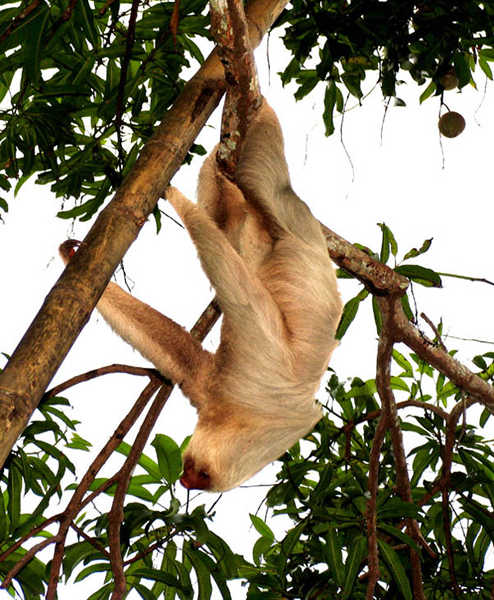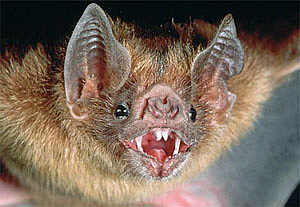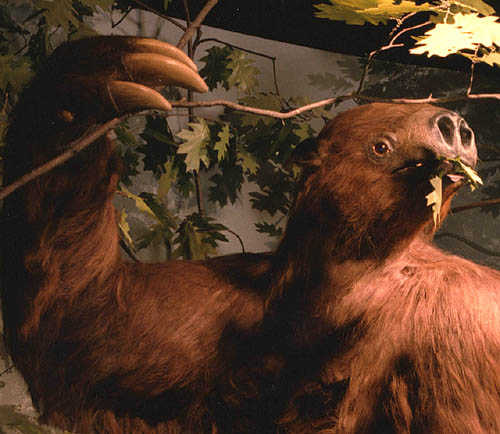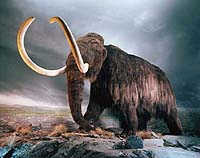 McDonald (1977) was the first to note the similarity of Megalonyx teeth to those of VAMPIRE BATS. Like sloths, but unlike other bats and most other mammals, the common vampire bat, Desmodus rotundus, has teeth that are comprised entirely of dentin, with a jacket of cementum. SEM analysis shows the thin layer of enamel that vampire bats have at birth wears away quickly (Freeman, 1998). As in Megalonyx, the bats’ teeth are ever-growing.
McDonald (1977) was the first to note the similarity of Megalonyx teeth to those of VAMPIRE BATS. Like sloths, but unlike other bats and most other mammals, the common vampire bat, Desmodus rotundus, has teeth that are comprised entirely of dentin, with a jacket of cementum. SEM analysis shows the thin layer of enamel that vampire bats have at birth wears away quickly (Freeman, 1998). As in Megalonyx, the bats’ teeth are ever-growing.  They compensate for the rapid wear of the soft material by grinding upper teeth against lower in a systematic way to keep them sharp (Phillips and Steinberg, 1976). Ever-growing teeth are common in rodents but the biting surface in this case is a combination of dentin and enamel. As the softer dentin erodes and the enamel precipice chips, the animals are left with a long-lasting but jagged edge. A nice tool for cutting and slicing plants and seeds, but vampire bats depend on stealth to secure their meals. A smooth razor blade works better than a serrated edge for shaving hair or feathers off a patch of skin and making a clean painless incision. The cementum jacket of the bats’ teeth is about as hard as the dentin, eliminating the chipping problem where they meet. But the ugly rumors about sloths and vampire bats didn’t get started simply because of tooth morphology. The scandal-mongers cite several other lines of evidence for making this unsavory connection.
They compensate for the rapid wear of the soft material by grinding upper teeth against lower in a systematic way to keep them sharp (Phillips and Steinberg, 1976). Ever-growing teeth are common in rodents but the biting surface in this case is a combination of dentin and enamel. As the softer dentin erodes and the enamel precipice chips, the animals are left with a long-lasting but jagged edge. A nice tool for cutting and slicing plants and seeds, but vampire bats depend on stealth to secure their meals. A smooth razor blade works better than a serrated edge for shaving hair or feathers off a patch of skin and making a clean painless incision. The cementum jacket of the bats’ teeth is about as hard as the dentin, eliminating the chipping problem where they meet. But the ugly rumors about sloths and vampire bats didn’t get started simply because of tooth morphology. The scandal-mongers cite several other lines of evidence for making this unsavory connection.
Some of the ground sloths, including Megalonyx, show a marked affinity for caves.  McDonald (2003) reports that 34 out of the 152 sites from which M. jeffersonii remains have been found are caves (including sinkholes, rock shelters and fissure fills). Nothrotheriops shastensis shows an even stronger association with caves—39 out of 52 known localities. In contrast, of the 168 late Pleistocene sites known for Paramylodon harlani, only 4 are true caves. The largest North American sloth, Eremotherium laurillardi, is known from just 10 late Pleistocene localities and none is a true cave. Clearly caves figure in the natural history of some sloths—whether to provide protection from predators, or shelter while sleeping or giving birth, or to help control body temperature in extremes of hot and cold, conserve water, or another reason is still TBD. (image borrowed from)
McDonald (2003) reports that 34 out of the 152 sites from which M. jeffersonii remains have been found are caves (including sinkholes, rock shelters and fissure fills). Nothrotheriops shastensis shows an even stronger association with caves—39 out of 52 known localities. In contrast, of the 168 late Pleistocene sites known for Paramylodon harlani, only 4 are true caves. The largest North American sloth, Eremotherium laurillardi, is known from just 10 late Pleistocene localities and none is a true cave. Clearly caves figure in the natural history of some sloths—whether to provide protection from predators, or shelter while sleeping or giving birth, or to help control body temperature in extremes of hot and cold, conserve water, or another reason is still TBD. (image borrowed from)
Obviously Megalonyx survived in locales without caves or natural rock shelters of any kind. In that case they may have simply dug burrows or settled into hollow trees (like bats). Remarkably, several apparent sloth burrows have survived to the present day in Argentina, measuring 1.8 meters in width and up to 40 meters long (Vizcaino et al. 2001). The claw marks inside are too large to have been left by the ice age armadillos, but match up well with the morphology of both the Glossotherium and Scelidotherium ground sloths. Frenguelli (1928) recovered the skeleton of a Scelidotherium within such a burrow.
 Modern tree sloths are also nocturnal like bats, but that’s an aversion to predators not daylight. McDonald (2003) suggests Nothrotheriops may have retreated to caves more often than other ground sloths to avoid the daytime heat of its desert habitat, waiting for the cool of the night to feed. However, the continent-wide distribution of Megalonyx suggests they had no such metabolic limitations. And an adult Megalonyx likely lost little sleep worrying about predators either, and so probably stayed in bed until the sun was up like the rest of us. (image borrowed from)
Modern tree sloths are also nocturnal like bats, but that’s an aversion to predators not daylight. McDonald (2003) suggests Nothrotheriops may have retreated to caves more often than other ground sloths to avoid the daytime heat of its desert habitat, waiting for the cool of the night to feed. However, the continent-wide distribution of Megalonyx suggests they had no such metabolic limitations. And an adult Megalonyx likely lost little sleep worrying about predators either, and so probably stayed in bed until the sun was up like the rest of us. (image borrowed from)
The scurrilous rumors have probably been reinforced by the lurid accounts of the giant vampire bats that lived here in the Ice Ages. The Pleistocene mammals included a diverse assortment of bats including vampires. Many accompanied their hosts into extinction.  The fabulously named Desmodes draculae, is estimated to have been about 25-30% larger than the common vampire bat of today (Freeman, 1998). Much still needs to be learned about the natural history of this mammal, especially its range. Blood is almost all protein, and without fat reserves vampire bats are highly sensitive to cold, raising questions about the ability of D. draculae to survive in northern climates. Uncertainty about the diet of Megalonyx, its renowned adaptability, the blood-sucking food-niche that was probably open in the North, and the aforementioned unsettling similarity of its teeth to Desmodes spp. are presumably responsible for the irresponsible speculation that Megalonyx may have been an opportunistic sanguivore. (image borrowed from)
The fabulously named Desmodes draculae, is estimated to have been about 25-30% larger than the common vampire bat of today (Freeman, 1998). Much still needs to be learned about the natural history of this mammal, especially its range. Blood is almost all protein, and without fat reserves vampire bats are highly sensitive to cold, raising questions about the ability of D. draculae to survive in northern climates. Uncertainty about the diet of Megalonyx, its renowned adaptability, the blood-sucking food-niche that was probably open in the North, and the aforementioned unsettling similarity of its teeth to Desmodes spp. are presumably responsible for the irresponsible speculation that Megalonyx may have been an opportunistic sanguivore. (image borrowed from)
 Megalonyx is generally believed to be a browser, of course (McDonald and Anderson, 1983), but how they ever managed to survive north of the Arctic Circle (Stock, 1942) is a wonder. Guthrie (1980) has proposed grasses flourished there in lieu of the moss and lichens that eke out their existence there today, supporting a broad range of grazers—the so-called mammoth steppe. It has been suggested that perhaps Megalonyx was supplementing its diet with something besides plants. Those nightmarish claws have been an enigma from the moment they were first discovered and then there are those teeth. . . and let’s be honest, this isn’t the first ground sloth cast as a possible psycho (Farino and Blanco, 1996). One might contemplate the thought that what was nipping at the toes of mammoths wasn’t Jack Frost, but blood-sucking sloths. . . .
Megalonyx is generally believed to be a browser, of course (McDonald and Anderson, 1983), but how they ever managed to survive north of the Arctic Circle (Stock, 1942) is a wonder. Guthrie (1980) has proposed grasses flourished there in lieu of the moss and lichens that eke out their existence there today, supporting a broad range of grazers—the so-called mammoth steppe. It has been suggested that perhaps Megalonyx was supplementing its diet with something besides plants. Those nightmarish claws have been an enigma from the moment they were first discovered and then there are those teeth. . . and let’s be honest, this isn’t the first ground sloth cast as a possible psycho (Farino and Blanco, 1996). One might contemplate the thought that what was nipping at the toes of mammoths wasn’t Jack Frost, but blood-sucking sloths. . . .
 Everyone has heard the stories of course–Dracula, the Undead, etc. . . . Myths about supernatural creatures that consume the blood of the living have come from nearly every culture on Earth since the beginning of recorded history (McNally, 1994). Could they originate in paleolithic folklore? Vampires in European mythology are usually described as bloated, ruddy in color and with long fingernails, as first depicted in cinema in the 1922 German silent film Nosferatu. Is the resemblance merely a coincidence or an unconscious connection to primal and well-founded fears? (image borrowed from)
Everyone has heard the stories of course–Dracula, the Undead, etc. . . . Myths about supernatural creatures that consume the blood of the living have come from nearly every culture on Earth since the beginning of recorded history (McNally, 1994). Could they originate in paleolithic folklore? Vampires in European mythology are usually described as bloated, ruddy in color and with long fingernails, as first depicted in cinema in the 1922 German silent film Nosferatu. Is the resemblance merely a coincidence or an unconscious connection to primal and well-founded fears? (image borrowed from)
Then there is the little matter of elephant garlic, Allium ameloprasum.  Garlic has been a part of folk medicine for thousands of years. Over 800 therapeutic formulas are listed in the Codex Ebers, the Egyptian medical papyrus dating to 1550 BC (Nguansangiam et al., 2003). Data on elephant garlic, a leek actually, is less complete but it has been shown to have some of the same effects as true garlic (Morita et al., 1988), including presumably its legendary ability to ward off vampires. Personally, I don’t think I’m going to lose any sleep worrying about vampire sloths walking at night with the Undead. But I still have one nagging question. . . so if there weren’t any vampires, what were the elephants doing with the garlic? (image borrowed from) Happy Halloween. . . Dave
Garlic has been a part of folk medicine for thousands of years. Over 800 therapeutic formulas are listed in the Codex Ebers, the Egyptian medical papyrus dating to 1550 BC (Nguansangiam et al., 2003). Data on elephant garlic, a leek actually, is less complete but it has been shown to have some of the same effects as true garlic (Morita et al., 1988), including presumably its legendary ability to ward off vampires. Personally, I don’t think I’m going to lose any sleep worrying about vampire sloths walking at night with the Undead. But I still have one nagging question. . . so if there weren’t any vampires, what were the elephants doing with the garlic? (image borrowed from) Happy Halloween. . . Dave
References
Farina, RA and Blanco, RE. 1996. Megatherium the stabber. Proceedings: Biological Sciences 263 (1477): 1725-1729.
Freeman, PW. 1998. Form, function, and evolution in skulls and teeth of bats. Bat Biology and Conservation. TH Kunz and PA Racey (eds.). Smithsonian Institution Press. Washington, D.C., pp. 140-156.
Frenguelli, J. 1928. Observaciones geologicas en la region costanera sur de la Provincia de Buenos Aires. Universdad Nacional del Litoral, Facultad de Ciencias de la Educacion, Anales 3: 101-130.
Guthrie, RD. 1990. Frozen Fauna of the Mammoth Steppe: The story of Blue Babe. The University of Chicago Press.
McDonald, HG. 1977. Description of the osteology of the extinxt gravigrade Edentate Megalonyx with observations on its ontongeny, phylogeny and functional anatomy. Masters thesis, University of Florida.
McDonald, HG and Anderson, DC. 1983. A well-preserved ground sloth (Megalonyx) cranium from Turin, Monona County, Iowa. Proceedings of the Iowa Academy of Science 90: 134-140.
McDonald, HG. 2003. Sloth remains from North American caves and associated karst features. Ice Age Cave Faunas of North America. B.W. Schubert, J.I. Mead and R.W. Graham (eds.), Denver Museum of Nature and Science, Denver, CO.
McNally, RT and Florescu, R. 1994. In search of Dracula: the history of Dracula and vampires. Houghton Mifflin Company. New York, NY.
Morita T, Ushiroguchi T, Hayashi N, Itakura Y, Fuwa T. 1988. Steroidal saponins from elephant garlic, Bulbs of Allium ampeloprasum L. Chemical and Pharmaceutical Bulletin 36: 3840-3846.
Nguansangiam, S, Angsubhakorn, S, Bhamarapravati, S and Suksamrarn, A. 2003. Effects of elephant garlic volatile oil (Allium ampeloprasum) and T-2 toxin on Murine skin. Southeast Asian Journal of Tropical Medicine Public Health 34: 899-905.
Phillips, CJ and Steinberg, B. 1976. Histological and scanning electron microscope studies of tooth structure and thegosis in the common vampire bat, Desmodus rotundus. Occasional Papers of the Museum of Texas Tech University 42: 1-12.
Stock, C. 1942. A ground sloth in Alaska. Science 95 (2474): 552-553.
Vizcaino, S.F., Zarate, M., Bargo, M.S., and Dondas, A. 2001. Pleistocene burrows in the Mar del Plarta area. Acta Palaeontologica Polonica 46: 289-301.

Good one Dave….
If you want to add to rumors, I still think we could make a case for sasquatch being a surviving Megalonyx. Though the foot structure and orientation is a little different, the preserved prints for Paramylodon in Nevada were first thought to belong to a large human. But the northern range for Megalonxy and lack of slow-moving adaptation that we see in the tree sloths makes it a likely candidate.
Or at least I like the idea of it being a sloth rather than a large “wood ape”
I suspect that most herbivores, if not all, will consume meat if given the opportunity. In my work with fossil micromammals, I occasionally kept rodents for pets and to observe their habits. I once had three meadow voles (prime grazers). For whatever reason, I put hamburger into their enclosure. They not only gobbled it up but but were not interested in grass, even when fresh, after that. The same proved to be true for deer mice. I did not carry this further because I felt cruel weaning them back to traditional fare. I suspect that sloths would go for animal protein but it would be opportunistic. But then, I have been subjected to years of conventional wisdom where sloth feeding habits have been transferred from one professors notes to those of others. Congratulations on a new idea! Holmes
hi Rob– I was surprised to discover many true Sasquatch believers are insulted by suggestions of a possible connection with ground sloths. Their beast is quick and wily–he must be to have eluded capture for so long! Sloths on the other hand are notoriously slow and stupid (they say). I don’t want to encourage them, so I bite my tongue and content myself with the quiet confidence that our guy could beat their guy any day. I give more credence to the Curse of the Megatherium Club documented at http://www.charliejacoby.com/giantsloth.htm. Holmes and I are clearly living on borrowed time.
Holmes, I can’t recall the reference off the top of my head but there has been some published work indicating that captive sloths will eat meat if given the opportunity. From a physiological aspect this certainly makes sense as any animal will take the benefits of adding new amino acid complexes to their system. Much easier to modify them than to make from scratch!
Ah, I just remembered. Merrit published on it in the 70-80’s, mostly in International Zoo Yearbook.
Dave, don’t let those sasquatch folk push you around. Modern sloths are slow by adaptation as a form of camouflage. No other Xenarthan exhibits slow movement (with maybe the exception of the silky anteater) and it is highly unlikely that any ground sloth moved at such a slow clip. So they are certainly viable candidates for being quick and wily! How else could they have come to such prominence in the North American megafauna and not be recorded (so far as we know) in “native american” histories? I say Slothsquatch 🙂
Pingback: Megalonyx: the blood-sucking ground sloth? « The Theatrical Tanystropheus
Pingback: The Tarkio Valley Sloth Project · The little matter of elephant garlic | www.caves.ca